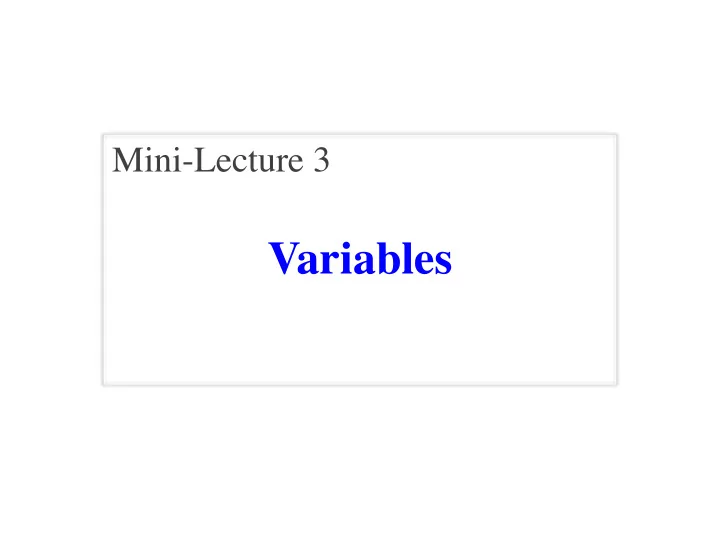

Mini-Lecture 3 Variables
Expressions vs Statements Expression Statement • Represents something • Does something § Python evaluates it § Python executes it § End result is a value § Need not result in a value • Examples: • Examples: Literal § 2.3 § print('Hello') § (3+5)/4 § import sys Complex Expression Will see later this is not a clear cut separation 8/29/18 Variables & Assignments 2
Variables (Section 2.1) • A variable is § a named memory location ( box ), § a value (in the box) • Examples x 5 Variable x , with value 5 (of type int ) area 20.1 Variable area , w/ value 20.1 (of type float ) • Variable names must start with a letter § So 1e2 is a float , but e2 is a variable name 8/29/18 Variables & Assignments 3
Variables and Assignment Statements • Variables are created by assignment statements § Create a new variable name and give it a value the value x = 3 the variable • This is a statement , not an expression § Tells the computer to DO something (not give a value) § Typing it into >>> gets no response (but it is working) • Assignment statements can have expressions in them § These expressions can even have variables in them the expression x = x + 2 the variable 8/29/18 Variables & Assignments 4
Execute the Statement: x = x + 2 • Draw variable x on piece of paper: x 5 • Step 1: evaluate the expression x + 2 § For x, use the value in variable x § Write the expression somewhere on your paper 8/29/18 Variables & Assignments 5
Execute the Statement: x = x + 2 • Draw variable x on piece of paper: x 5 • Step 1: evaluate the expression x + 2 § For x, use the value in variable x § Write the expression somewhere on your paper • Step 2: Store the value of the expression in x § Cross off the old value in the box § Write the new value in the box for x 8/29/18 Variables & Assignments 6
Which One is Closest to Your Answer? A: B: x x 5 7 x 5 x 7 C: D: x x 5 ¯\_( � )_/¯ x 7 8/29/18 Variables & Assignments 7
Which One is Closest to Your Answer? A: B: x x 5 7 x 5 � x 7 C: x x 5 x = x + 2 x 7 8/29/18 Variables & Assignments 8
Assignment Statements • Make new variables: interestRate = 4 x x x 5 7 x 5 7 interestRate 4 • Change existing variables: x = 3.0 * x + 1.0 x x x x 5 7 x 5 7 22.0 interestRate 4 interestRate 4 8/29/18 Variables & Assignments 9
But Beware of Misspellings intrestRate = x + interestRate x x x 5 7 22.0 x x x 5 7 22.0 interestRate 4 interestRate 4 intrestRate 26.0 8/29/18 Variables & Assignments 10
But Beware of Misspellings intrestRate = x + interestRate x x x 5 7 22.0 x x x 5 7 22.0 interestRate 4 interestRate 4 intrestRate 26.0 8/29/18 Variables & Assignments 11
Dynamic Typing • Python is a dynamically typed language § Variables can hold values of any type § Variables can hold different types at different times § Use type(x) to find out the type of the value in x § Use names of types for conversion, comparison type(x) == int x = float(x) • The following is acceptable in Python: type(x) == float >>> x = 1 ç x contains an int value ç x now contains a float value >>> x = x / 2.0 • Alternative is a statically typed language (e.g. Java) § Each variable restricted to values of just one type 8/29/18 Variables & Assignments 12
Dynamic Typing • Often want to track the type in a variable § What is the result of evaluating x / y? § Depends on whether x, y are int or float values • Use expression type(<expression>) to get type § type(2) evaluates to <type 'int'> § type(x) evaluates to type of contents of x • Can use in a boolean expression to test type § type('abc') == str evaluates to True 8/29/18 Variables & Assignments 13
Recommend
More recommend